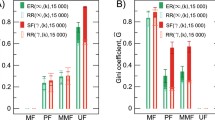Abstract
Congestion in the Internet is the main reason for reduced performance and poor quality of service; therefore, a good congestion control system is essential. The current work proposes that the congestion control problem in the Internet can be inspired from natural population control tactics. Toward this idea, the congestion window size of each connection is viewed as population size of a species and then congestion control problem is redefined as population control of these windows species (W). This paper defines a three-trophic food chain and gives a model to control population size of W species within this food chain. Simulation results show that the proposed algorithm leads to a fair, stable and high-performance congestion control scheme.




Similar content being viewed by others
References
Floyd, S., Jacobson, V.: Random early detection gateways for congestion avoidance. IEEE/ACM Trans. Netw. 1, 397–413 (1993)
Floyd, S.: High speed TCP for large congestion windows. Internet draft, June 2002
D’haeseleer, P., Forrest, S.: An immunological approach to change detection: algorithms, analysis and implications. IEEE (1996)
Dressler, F.: Efficient and scalable communication in autonomous networking using bio-inspired mechanisms—an overview. Informatica 29, 183–188 (2005)
Analoui, M., Jamali, Sh.: A conceptual framework for bio-inspired congestion control in communication networks. IEEE/ACM BIONETICS (2006)
Murray, J.D.: Mathematical Biology: I. An Introduction, 3rd edn. Springer press (2002)
Analoui, M., Jamali, Sh.: Bio-inspired Congestion Control: Conceptual Framework, Algorithm and Discussion, Book chapter. Springer SCI series (2007, to appear)
Analoui, M., Jamali, Sh.: Equation-based congestion control in the internet biologic environment. J LNCS Trans. Comput. Syst. Biol. (TCSB) (2007, to appear)
Takeuchi, Y., Adachi, N.: Global stability of ecosystem of the generalized volterra type. Math. BioSci. 42, 119–136 (1978)
Ramakrishna, K., Floyd, S., Black, D.: The addition of explicit congestion notification (ECN) to IP, RFC 3168 (2001)
Analoui, M., Jamali, Sh.: TCP fairness enhancement through a parametric mathematical model. IEEE CCSP2005 (2005)
Acknowledgement
This work has been supported by Iran Telecommunication Research Center.
Author information
Authors and Affiliations
Corresponding author
Additional information
Morteza Analoui and Shahram Jamali present an interesting way of treating network congestion. In its simplest form it amounts to finding the flow hogging the most bandwidth, I mean data rate, and killing it. Their approach seems to provide network justice and dispenses with the notion fairness to those who abuse it.
Rights and permissions
About this article
Cite this article
Analoui, M., Jamali, S. Congestion Control in the Internet: Inspiration from Balanced Food Chains in the Nature. J Netw Syst Manage 16, 1–10 (2008). https://doi.org/10.1007/s10922-007-9093-6
Published:
Issue Date:
DOI: https://doi.org/10.1007/s10922-007-9093-6




